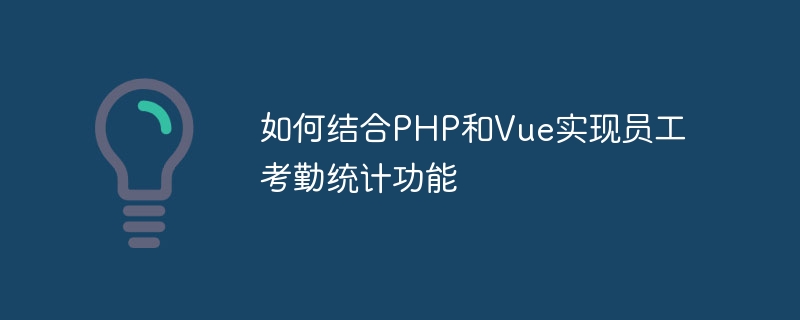 Backend Development
Backend Development
 PHP Tutorial
PHP Tutorial
 How to combine PHP and Vue to implement employee attendance statistics function
How to combine PHP and Vue to implement employee attendance statistics function
How to combine PHP and Vue to implement employee attendance statistics function

How to combine PHP and Vue to implement employee attendance statistics function?
With the continuous expansion of the scale of enterprises, employee attendance statistics have become an important part of enterprise management. With the help of two powerful technologies, PHP and Vue, we can easily implement the employee attendance statistics function and provide a good user experience.
Below, I will use a simple example to show how to combine PHP and Vue to achieve this function. First, we need to build a simple backend interface to obtain employee attendance data.
The PHP backend code is as follows:
<?php
// 获取员工考勤数据
function getAttendanceData() {
// 这里可以连接数据库,查询员工考勤数据并返回
$attendanceData = [
['name' => '张三', 'date' => '2022-01-01', 'status' => '正常'],
['name' => '李四', 'date' => '2022-01-02', 'status' => '迟到'],
['name' => '王五', 'date' => '2022-01-03', 'status' => '早退'],
// 其他员工考勤数据
];
return json_encode($attendanceData);
}
// 输出员工考勤数据
echo getAttendanceData();
?>The above code defines a simple function getAttendanceData, which is used to obtain employee attendance data. Here we just simulate some data and output the data in JSON format through the json_encode function.
Next, we use Vue to build the front-end interface, and use Ajax to request the back-end interface to obtain employee attendance data.
The front-end code is as follows:
<!DOCTYPE html>
<html>
<head>
<title>员工考勤统计</title>
<script src="https://cdn.jsdelivr.net/npm/vue/dist/vue.js"></script>
<script src="https://cdn.jsdelivr.net/npm/axios/dist/axios.min.js"></script>
</head>
<body>
<div id="app">
<h1 id="员工考勤统计">员工考勤统计</h1>
<table>
<thead>
<tr>
<th>姓名</th>
<th>日期</th>
<th>状态</th>
</tr>
</thead>
<tbody>
<tr v-for="attendance in attendances" :key="attendance.name">
<td>{{ attendance.name }}</td>
<td>{{ attendance.date }}</td>
<td>{{ attendance.status }}</td>
</tr>
</tbody>
</table>
</div>
<script>
new Vue({
el: '#app',
data: {
attendances: []
},
mounted() {
this.getAttendanceData();
},
methods: {
getAttendanceData() {
axios.get('api.php') // 调用后端接口
.then(response => {
this.attendances = response.data;
})
.catch(error => {
console.log(error);
});
}
}
});
</script>
</body>
</html>In the above code, we use the Vue and Axios libraries. The getAttendanceData method is called in Vue's mounted life cycle hook, which uses Axios to send a GET request to the back-end interface api.php to obtain employee attendance data. And assign the returned data to the attendances array. Through Vue's two-way binding, we can display employee attendance data in the table.
It should be noted that in actual projects, you need to make appropriate modifications and expansions according to your own needs, such as adding more data fields, adding, deleting, modifying, and checking data.
By combining PHP and Vue, we successfully implemented a simple employee attendance statistics function and provided users with a good user experience. This is just a basic example, I hope it will be helpful to you in the development of actual projects.
The above is the detailed content of How to combine PHP and Vue to implement employee attendance statistics function. For more information, please follow other related articles on the PHP Chinese website!

Hot AI Tools

Undresser.AI Undress
AI-powered app for creating realistic nude photos

AI Clothes Remover
Online AI tool for removing clothes from photos.

Undress AI Tool
Undress images for free

Clothoff.io
AI clothes remover

AI Hentai Generator
Generate AI Hentai for free.

Hot Article

Hot Tools

Notepad++7.3.1
Easy-to-use and free code editor

SublimeText3 Chinese version
Chinese version, very easy to use

Zend Studio 13.0.1
Powerful PHP integrated development environment

Dreamweaver CS6
Visual web development tools

SublimeText3 Mac version
God-level code editing software (SublimeText3)

Hot Topics
 CakePHP Project Configuration
Sep 10, 2024 pm 05:25 PM
CakePHP Project Configuration
Sep 10, 2024 pm 05:25 PM
In this chapter, we will understand the Environment Variables, General Configuration, Database Configuration and Email Configuration in CakePHP.
 PHP 8.4 Installation and Upgrade guide for Ubuntu and Debian
Dec 24, 2024 pm 04:42 PM
PHP 8.4 Installation and Upgrade guide for Ubuntu and Debian
Dec 24, 2024 pm 04:42 PM
PHP 8.4 brings several new features, security improvements, and performance improvements with healthy amounts of feature deprecations and removals. This guide explains how to install PHP 8.4 or upgrade to PHP 8.4 on Ubuntu, Debian, or their derivati
 CakePHP Date and Time
Sep 10, 2024 pm 05:27 PM
CakePHP Date and Time
Sep 10, 2024 pm 05:27 PM
To work with date and time in cakephp4, we are going to make use of the available FrozenTime class.
 CakePHP File upload
Sep 10, 2024 pm 05:27 PM
CakePHP File upload
Sep 10, 2024 pm 05:27 PM
To work on file upload we are going to use the form helper. Here, is an example for file upload.
 CakePHP Routing
Sep 10, 2024 pm 05:25 PM
CakePHP Routing
Sep 10, 2024 pm 05:25 PM
In this chapter, we are going to learn the following topics related to routing ?
 Discuss CakePHP
Sep 10, 2024 pm 05:28 PM
Discuss CakePHP
Sep 10, 2024 pm 05:28 PM
CakePHP is an open-source framework for PHP. It is intended to make developing, deploying and maintaining applications much easier. CakePHP is based on a MVC-like architecture that is both powerful and easy to grasp. Models, Views, and Controllers gu
 How To Set Up Visual Studio Code (VS Code) for PHP Development
Dec 20, 2024 am 11:31 AM
How To Set Up Visual Studio Code (VS Code) for PHP Development
Dec 20, 2024 am 11:31 AM
Visual Studio Code, also known as VS Code, is a free source code editor — or integrated development environment (IDE) — available for all major operating systems. With a large collection of extensions for many programming languages, VS Code can be c
 CakePHP Creating Validators
Sep 10, 2024 pm 05:26 PM
CakePHP Creating Validators
Sep 10, 2024 pm 05:26 PM
Validator can be created by adding the following two lines in the controller.





